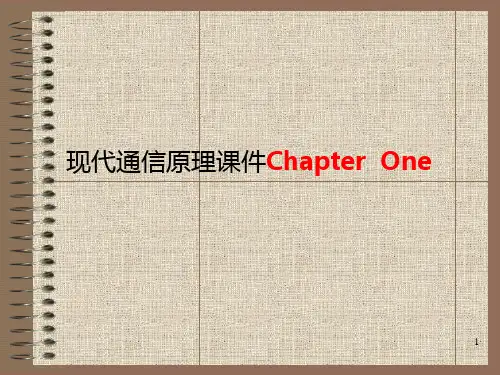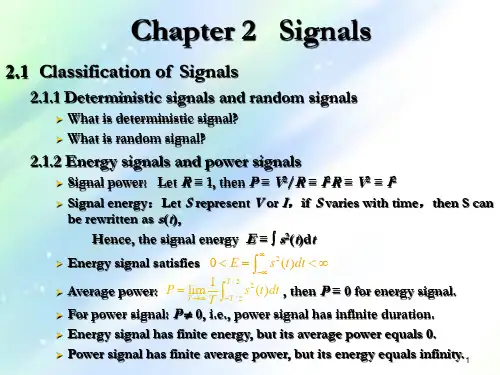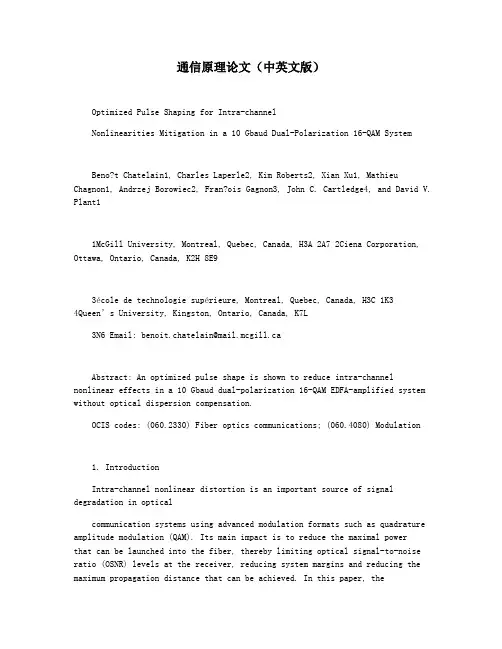演示文稿通信原理英文版
- 格式:ppt
- 大小:3.22 MB
- 文档页数:44

通信原理英文Communication PrinciplesCommunication principles refer to the fundamental concepts and theories that govern the process of transmitting information from one entity to another. These principles form the foundation of effective communication and play a crucial role in various communication systems, such as wireless communication, optical communication, and digital communication.One of the key communication principles is the concept of encoding and decoding. Encoding involves converting the information into a suitable form for transmission, while decoding involves the reverse process of converting the received signals back into meaningful information. This principle ensures that the information is accurately transmitted and understood by the receiving entity.Another important principle is the concept of modulation. Modulation is the process of modifying a carrier signal by varying its amplitude, frequency, or phase to carry the information. This principle is used in various communication systems to transmit information over long distances without significant loss or distortion.Furthermore, the principle of noise reduction is crucial in communication systems. Noise refers to any unwanted disturbance that affects the quality of the transmitted signal. To ensure reliable and clear communication, noise reduction techniques, such as filtering and error correction, are employed to minimize the impactof noise on the received signals.Additionally, the principle of multiplexing allows multiple signals to be transmitted over a single communication channel. This is achieved by dividing the channel bandwidth into smaller sub-channels, each carrying a different signal. Multiplexing enables efficient utilization of the available communication resources and allows for simultaneous transmission of multiple signals.Furthermore, the principle of synchronization is essential for successful communication. Synchronization ensures that the transmitting and receiving entities are operating in a coordinated manner, allowing for accurate transmission and reception of the information. Various techniques, such as clock synchronization and frame synchronization, are employed to achieve synchronization in communication systems.Lastly, the principle of error detection and correction is crucial for reliable communication. Error detection techniques, such as checksums and parity bits, are used to identify errors in the transmitted signals. Error correction techniques, such as forward error correction codes, are employed to correct the detected errors and ensure accurate transmission and reception of the information. In summary, communication principles are fundamental concepts and theories that govern the process of transmitting information. These principles, such as encoding and decoding, modulation, noise reduction, multiplexing, synchronization, and error detection and correction, ensure efficient and reliable communication in various communication systems.。


通信原理怎么说英语作文Communication Principles。
Communication is the process of exchanging information, ideas, and feelings between individuals or groups. It plays a crucial role in our daily lives, enabling us to connect with others, share knowledge, and express ourselves. Inthis essay, we will explore the principles of effective communication and how they contribute to building strong relationships and achieving successful outcomes.Firstly, one of the key principles of communication is clarity. It is essential to convey information in a clear and concise manner, using simple and understandable language. Ambiguity and confusion can lead to misunderstandings and hinder effective communication. Therefore, individuals should strive to express their thoughts and ideas in a straightforward and unambiguous way.Another important principle is active listening.Effective communication is a two-way process, where both the speaker and the listener play an active role. Active listening involves paying full attention to the speaker, understanding their message, and providing feedback. By actively listening, we can better comprehend the speaker's intentions, feelings, and needs, thereby strengthening the communication process.Moreover, non-verbal communication is a powerful tool that complements verbal communication. Non-verbal cues such as facial expressions, body language, and gestures can convey emotions and attitudes. For instance, a smile can indicate friendliness and openness, while crossed arms may signal defensiveness or disagreement. Being aware of these non-verbal signals can help us interpret the underlying messages and enhance our overall understanding.Furthermore, empathy is an essential aspect ofeffective communication. Empathy involves understanding and sharing the feelings of others. By putting ourselves in someone else's shoes, we can better relate to their experiences and perspectives. This understanding allows usto communicate with compassion and sensitivity, fostering trust and building stronger relationships.In addition, feedback is a vital component of effective communication. Providing constructive feedback helps to clarify expectations, address concerns, and improve performance. It is important to give feedback in arespectful and non-threatening manner, focusing on specific behaviors or actions rather than personal attacks. By offering feedback, we can encourage growth and developmentin both personal and professional relationships.Lastly, cultural awareness is crucial in today's globalized world. Different cultures have unique communication styles, norms, and values. Being mindful of these cultural differences can prevent misunderstandingsand facilitate effective communication. It is important to respect and appreciate diverse perspectives, adapting our communication approach to accommodate cultural variations.In conclusion, effective communication is essential in all aspects of life. By following the principles of clarity,active listening, non-verbal communication, empathy, feedback, and cultural awareness, we can establish meaningful connections, resolve conflicts, and achieve successful outcomes. Communication is a skill that can be developed and improved upon, and by practicing these principles, we can become more effective communicators.。








通信原理论文(中英文版)Optimized Pulse Shaping for Intra-channelNonlinearities Mitigation in a 10 Gbaud Dual-Polarization 16-QAM SystemBeno?t Chatelain1, Charles Laperle2, Kim Roberts2, Xian Xu1, Mathieu Chagnon1, Andrzej Borowiec2, Fran?ois Gagnon3, John C. Cartledge4, and David V. Plant11McGill University, Montreal, Quebec, Canada, H3A 2A7 2Ciena Corporation, Ottawa, Ontario, Canada, K2H 8E93école de technologie supérieure, Montreal, Quebec, Canada, H3C 1K34Queen’s University, Kingston, Ontario, Canada, K7L3N6 Email: benoit.chatelain@mail.mcgill.caAbstract: An optimized pulse shape is shown to reduce intra-channel nonlinear effects in a 10 Gbaud dual-polarization 16-QAM EDFA-amplified system without optical dispersion compensation.OCIS codes: (060.2330) Fiber optics communications; (060.4080) Modulation1. IntroductionIntra-channel nonlinear distortion is an important source of signal degradation in opticalcommunication systems using advanced modulation formats such as quadrature amplitude modulation (QAM). Its main impact is to reduce the maximal powerthat can be launched into the fiber, thereby limiting optical signal-to-noise ratio (OSNR) levels at the receiver, reducing system margins and reducing the maximum propagation distance that can be achieved. In this paper, thenonlinear tolerance of an optimized pulse and a root-raised cosine (RRC) pulse is compared in terms of bit error rate (BER) performance, for varying propagation distances and launch powers. Experimental results show that the optimized pulse considerably reduces intra-channel nonlinear effects in a long haul, 10 Gbaud dual-polarization (DP) 16-QAM system relying on erbium-doped fiber amplifiers (EDFAs) and G.652 fiber (no optical dispersion compensation).The improved nonlinear tolerance of the return-to-zero (RZ) pulse shape was recently highlighted in [1], for a 112 Gb/s DP-quadrature phase shift keying (QPSK) system without optical dispersion compensation. Comparing the RZ pulse to the non return-to-zero (NRZ) pulse, the authors reported an increase in single channel maximum propagation distance of 18%. However, the improved nonlinear tolerance achieved using the RZ pulse comes at the expense of increased spectral content. For instance, the bandwidth of a 50% RZ pulse is twice the bandwidth of the NRZ pulse or the RRC pulse with a roll-off factor (α) of 1. The use of a RZ pulse thus reduces spectral efficiency by a factor of two, and for a system using digital signal processing at the transmitter and receiver, at the Nyquist rate, it doubles the required bandwidth and sampling frequency of the digital-to-analog converters (DACs) and analog-to-digital converters (ADCs).(a)(b)Figure 1. Impulse (a) and frequency (b) responses of the RRC and optimized pulses.In comparison to the RRC pulse, the optimized pulse shape presented in [2] was shown to improvethe nonlinear performance of DP-QPSK systems without optical dispersion compensation and to increase the maximum transmission distance by as much as 22%. The specialized pulse was obtained by numerical optimization, with the primary objective formulated to reduce its width, but constrained to have a bandwidth equal to the bandwidth of a NRZ or RRC pulse (α = 1). Therefore,the optimized pulse can be used without penalizing spectral efficiency and without using higher speed DACs and ADCs. Fig. 1 exhibits the time and frequency characteristics of the optimized and RRC pulses. It can be seen that the optimized pulse is narrower than the RRC pulse with α = 1, and that its first-null bandwidth is equal to the baud rate. It is also apparent that the reduced width of the optimized pulse translates in higher energy content for frequencies between 6 GHz and 10 GHz. Through dispersion, the higher energy frequencycomponents produce a propagating pulse and a propagating waveformthat is more broadened, with lower peak power excursions. Since intra-channel nonlinear distortion is proportional to peak power, the optimized pulse makes the system more tolerant to nonlinear effects. In this work and as in [2?5], the RRC pulse is used as the reference pulse for its ability to minimizepulse-induced intersymbol interference (ISI) and to minimize out-of-band power.2. Experimental SetupFig. 2 illustrates the experimental setup. The symbol sources consist of random symbol sequences of length 214 and were followed by pulse shapingfinite impulse response (FIR) filters. DACs with 6-bit resolution drive thein-phase-quadrature (I-Q) modulators associated with the two polarizations. The emitting wavelength was set to 1547.715 nm. A polarization scrambler (PS) was inserted after the polarization beam combiner (PBC) in order to randomly rotate the polarization state. A fiber link consisting of 15 spans of 80 km G.652 fiber was used, together with EDFAs at each span. At the receiver, a noise source was used to adjust the OSNR. The optical spectrum analyzer (OSA) served the purposes of measuring the OSNR. A coherent front-end integrates polarization beam splitters, optical hybrids, a local oscillator and photodetectors [6]. It provides four signals corresponding to the in-phase and quadrature components of the two polarizations. These baseband signals were sampled using a 50 GSa/s oscilloscope with 8-bit ADCs and post-processed in a personal computer. The linewidth of the transmitter and receiver lasers was 100 kHz, and their frequency offset was below 200 MHz. The same clockreference was used for the DACs and ADCs. The receiver signal processingfunctions include matched filtering and chromatic dispersion compensation (CD-1) by FIR filters, polarization recovery by a 13-tap fractionally spaced (T/2) butterfly equalizer (EQ), carrier offset removal and carrier phase recovery by a second order phase lock loop (PLL) and finally, detection. The constant modulus algorithm (CMA) is used for the equalizer coefficients pre-convergence. Once the signal is recovered, the system switches to a decision-directed modulus algorithm (DDMA) [7]. Two symbol pattern periods, totaling 215 symbols for each polarization, were used to produce BER statistics.In what follows, the system performance is studied using either the RRC pulse or the optimized pulse presented in Fig. 1 as transmit FIR filters and receive matched filters.Figure 2. Experimental setup.3. Results and DiscussionFig. 3 displays the electrical eye diagrams of the signal in-phase component taken at the transmitter, after the FIR pulse shaping filter. The inner eye openings of the optimized 16-QAM sequence eye diagram are reduced compare to those in the eye diagram obtained using the RRC pulse, indicating, as mentioned in [2], that the optimized pulse may be more sensitive to timing jitter. Fig. 3 (b) further shows that the eye diagram obtained with the optimized pulse is very similar to the eye diagram that would be obtainedusing an RZ pulse, and that the optimized pulse sequence returns close to azero level between each symbol period. Since the RRC and the optimized pulses are designed to be used as matched filter, it is expected to visualize on the eye diagrams at the transmitter a certain amount of ISI. The RRC and optimized pulses produce a filtered sequence with zero pulse-induced ISI only at the receiver, after matched filtering.Fig. 4 (a) reports the measured BER in a back-to-back configuration for a system using RRC filters and for a system using optimized filters. The linear performance of the RRC and optimized pulses is very similar and for the considered range of OSNR, the minimal and maximal penalty is 2.5 dB and 6.5 dB, respectively. Fig. 4 (b) and (c) show propagation results for 800 km and for 1200 km. At 800 km and considering a BER threshold of 8×10-3, the optimized pulse reduces the OSNR penalty by 0.6 dB and 2.8 dB, for launch powers of �C2 dBm and 0 dBm, respectively. At 1200 km and for a launch power of �C2 dBm an improvement of 1.2 dB is observed. At 1200 km and for a launch power of 0 dBm, the system with optimized pulse shaping almost reaches the BER threshold,while the system using RRC pulses is limited to a BER of 1.8×10-2. At this level, the optimized pulse outperforms the RRC pulse by 4.3 dB. It should be noted that the introduction of soft-decision forward error correction (FEC) [8] would be required to be able to operate at the considered BER threshold.感谢您的阅读,祝您生活愉快。
⽆线通信原理双语讲义第⼀⼆讲Course Code: B020305Course Title: Wireless Communications Principle and Practice (T. S. Rappaport 2004) Academic Year : 2015 Semester: 2Lecturer: Gao Huanqin (Room1610), College of Commu. and Inform.Engineering,NJUPT Lectures: 32 hours, lectured in English partially.E-mail Address: gaohq@/doc/e24373aa26fff705cc170ad9.html .au前⾔Preface (PP:1)本节课是本课程的第⼀堂课,介绍课程的相关信息;讲授第⼀章教学内容“⽆线通信概述”,它涉及英⽂教科书的第⼀、第⼆章内容。
Content(教学内容)s: Provide fundamental treatment about many practical and theoretical concepts that form the basis of wireless communications, especially fundamental cellular radio concepts such as frequency reuse. Propagation path loss prediction models for cellular networks, multiple access method. ⽆线通信基础相关的基本理论、概念与应⽤,突出基本概念与基础理论,例如蜂窝⽹中频率复⽤。
基础理论例如传播路径损耗预测模型,多址接⼊技术等。
Objective of the course(教学⽬标): After the course the student has a good basic knowledge of cellular and personal communication systems and the systems evolving from it. Also, the student will get a basic knowledge of the design of cellular networks and understand the special requirements, which result from the mobile radio environment. 通过本课程的学习让同学了解⽆线蜂窝通信系统的基本概念、基础理论以及系统演进,了解移动⽆线环境下的蜂窝通信⽹络系统的设计及需求。
Experiment Title: Basic Principles of Communication SystemsDate: [Insert Date]Objective: The objective of this experiment was to understand the basic principles of communication systems, including the transmission and reception of signals, modulation techniques, and demodulation processes. Through this experiment, we aimed to familiarize ourselves with the theoretical concepts and practical applications of various communication methods.Materials and Equipment:- Communication System Trainer- Signal Generator- oscilloscope- Function Generator- Power Supply- Communication channel simulator- Modulator and Demodulator UnitsExperiment Procedure:1. Signal Generation and Transmission:- The experiment began with generating a sinusoidal signal using the signal generator. This signal served as the input for the communication system.- The generated signal was then passed through the communication channel simulator, which simulated the effects of a real-world communication channel, such as noise and attenuation.- The output of the channel simulator was observed using the oscilloscope to ensure that the signal had undergone the desired transmission process.2. Modulation Techniques:- To enhance the signal's ability to carry information over a long distance and reduce the impact of noise, modulation techniques were applied.- Amplitude Modulation (AM) was performed by adjusting the amplitude of the carrier signal in accordance with the message signal.- Frequency Modulation (FM) was also demonstrated by varying the frequency of the carrier signal based on the message signal.- The modulated signals were then observed on the oscilloscope to analyze the effects of modulation on the signal.3. Demodulation Process:- After modulation, the next step was to demodulate the received signal to retrieve the original message signal.- For AM, the process involved extracting the amplitude information from the modulated signal using a demodulator.- Similarly, for FM, the demodulator extracted the frequency information to reconstruct the message signal.- The demodulated signals were compared with the original signal to evaluate the effectiveness of the demodulation process.4. Error Detection and Correction:- To ensure the integrity of the transmitted information, error detection and correction techniques were implemented.- A simple parity check was used to detect errors in the received signal.- In case of errors, the receiver requested the retransmission of the data to ensure accuracy.Results and Discussion:1. Signal Transmission:- The transmission of the signal through the communication channel simulator was successful, and the output signal was observed on the oscilloscope.- The presence of noise and attenuation in the channel was evident from the distorted waveform.2. Modulation Techniques:- The modulation techniques were successfully applied to the input signal, and the modulated signals were observed on the oscilloscope.- AM and FM techniques were effective in enhancing the signal's ability to carry information over a long distance.3. Demodulation Process:- The demodulation process was successful, and the demodulated signals were compared with the original signal to ensure accuracy.- The AM and FM demodulated signals were in close agreement with the original signal, indicating a successful demodulation process.4. Error Detection and Correction:- The parity check method was effective in detecting errors in the received signal.- The error detection mechanism ensured that the transmitted information was accurate and reliable.Conclusion:This experiment provided a comprehensive understanding of the basic principles of communication systems. The successful transmission, modulation, demodulation, and error detection and correction processes demonstrated the effectiveness of various communication techniques. Through this experiment, we gained practical experience in implementing and analyzing communication systems, which will be beneficial in our future studies and applications in the field of telecommunications.References:- [Insert relevant references to textbooks, articles, or online resources used during the experiment.]Appendix:- [Insert any additional data, graphs, or tables that support the findings of the experiment.]。